Morning at the Museum of Western and Eastern Art in Odesa: A Ukraine city under increased recent bombardment as Russia targets Black Sea and Danube river ports exporting grain through an agreed corridor. The museum, a magnificent neo-classical building, is all but empty, its eclectic collection taken to the safety of vaults and shelters.
Director Igor Poronik conducts a tour, replete with information about the collection that can nowadays only be seen in a book. Then I notice, on the wall of a now empty exhibition space: a reproduction, surely, of the The Taking of Christ by Caravaggio, known to the world for its pride of place in the National Gallery of Ireland, and remarkable recent discovery and attribution.
“No it’s not,” says Dr Poronik, with calm confidence, “it’s our Caravaggio”.
“Really?” I say.
RM Block
“Yes,” he affirms.
“Are you sure? – a Caravaggio, in Odesa?” “Absolutely,” replies the director. And here, in the middle of the biggest war of our lifetimes, a door opens unexpectedly, into a thriller, regarding what Italians call Ukraine’s “presunto Caravaggio” – presumed Caravaggio – its theft, dramatic recovery and debate over its authenticity.
There in the reproduction – which, on closer inspection, is not of the Dublin painting – is, nevertheless, that same dynamic thrust from right to left, towards the subject of this violent apprehension, accentuated by the light source from a lantern held aloft by an onlooker (a “presunto” self-portrait of Caravaggio himself) and the glaucous, brutal metal of a soldier’s armoured sleeve. There is the chiaroscuro claustrophobia of this awful moment; there is Christ’s expression of acceptance of the divine deal, with human desolation. There is the apostle in flight at left, in outraged fear and disbelief. So what on earth is going on?
The painting that hung on the wall of Odesa’s museum for much (but by no means all) of the 20th century is currently in Kyiv, undergoing restoration following its theft by a mafia gang in 2008. But that is not the beginning of the story – nor is it the end.
The possibility of an authentic Caravaggio Taking of Christ in Ukraine is of clear and present interest to the art world in general, but especially so in Ireland, where one of the most famously dramatic recent attributions of any painting occurred with regard to Caravaggio’s shattering depiction of that scene currently held by the National Gallery of Ireland.
Where does the trail begin? The first undisputed record of the Odesa painting’s recent trajectory appears in the catalogue of an auction held in Paris during 1868, among the assets of Russian collector (with origins in Ukraine) Alexander Petrovich Basilevsky. The work is here attributed to “Michel-Ange” – Caravaggio’s real name being Michelangelo Merisi – and entitled Le Baiser de Judas, the Kiss of Judas. There is no documentation to date on how it came into Basilevsky’s possession.
In 1870, the painting was given by Basilevsky to the Russian Tsar’s brother, Vladimir Alexandrovich Romanov, who had undertaken an art-collecting drive, advised by his friend Alfred Darcel, a renowned French museum curator and art critic. The painting was put on show at the St Petersburg Academy of Fine Arts, now entitled The Betrayal by Judas Iscariot, and attributed to “Michel-Ange”.
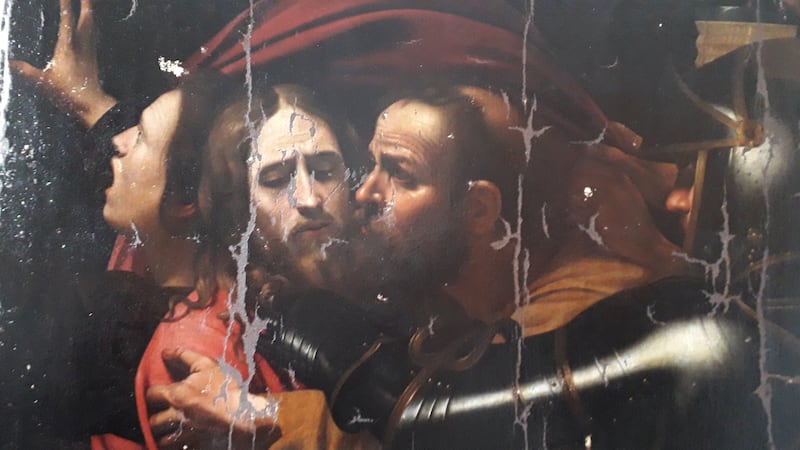
In 1901, the work, accompanied by 27 others, was transferred to Odesa, as part of the elevation of the port city’s status – now the fourth largest in the empire – with its colonial connections to Catherine the Great and role as Russia’s gateway to global trading markets. The civil war that followed the Bolshevik revolution ebbed to and fro across Odesa as Red, then White, forces occupied the city, and in 1923, the victorious communists transferred the painting to the Museum of Western and Eastern Art.
From 1941, Odesa was bombed and occupied by Romanian and German troops. Some paintings were prioritised for evacuation east, but the “Michel-Ange” was not among them, perhaps because of its religious theme. Maybe for that reason, or some other, it was instead taken for safekeeping by the Catholic Church – along with 13 other sacred works – to the Cathedral of the Assumption of Virgin Mary, on what was then Odesa’s Katerynska Street, named after Catherine the Great. (The cathedral was hit by a Russian missile in July this year.)
Within a year of reoccupation by the Red Army, the church returned all 14 paintings to Soviet authorities, and the “Michel-Ange” was again put on display.
But it was in an appalling condition, and in 1951 it was sent to the Grabar Institute in Moscow for restoration. X-rays were taken and in 1998, the work was first exhibited abroad, in Munich, as a “Caravaggio”. It toured further international exhibitions in Santiago de Compostela (2004), Milano and Düsseldorf (2005). It was on these tours that western experts were able to take a proper look, and most concluded, privately rather than in any scholarly thesis, that this was probably a copy of Caravaggio’s original.
For by that time, something remarkable had happened, in Ireland. The story is so well known that a brief recap will suffice here. Following the Irish Easter Rising in 1916, a British army officer called Percival Lea-Wilson was identified as having directed the brutal torture of nationalist revolutionary Thomas Clarke, who was subsequently executed. Lea-Wilson, known also for rough treatments of other prisoners after the Rising, was stalked by the IRA Commander Michael Collins during the War of Independence, identified as serving as an officer for the Royal Irish Constabulary and duly assassinated in June 1920.
The widowed Ms Lea-Wilson, who went on to train as a doctor, happened to attend an auction in Glasgow, at which the picture was for sale attributed to a Flemish artist called Gerrit van Honthorst. She bought it, but it was too large for her house, and (although a Protestant) donated it to the Society of Jesus in Dublin, to hang in its refectory.
Fast forward to a summer’s afternoon in August 1990: Sergio Benedetti, an expert on early Italian painting and a restorer at the National Gallery of Ireland (later head curator – he remained there for 30 years), took a stroll to the Jesuit community house on Leeson Street, to inspect paintings in its collection. The Jesuit Fr Superior Noel Barber thought some of them might be in need of a clean, including a gift from Dr Lea-Wilson, covered in dirt and varnish. It was a casual visit, but Benedetti recognised what he beheld, to his dumbfounded amazement: the long-lost original of a painting by Caravaggio, much referred to during and since its execution in 1602, widely known in various copies, but vanished.
[ Sergio Benedetti: The man who found a Caravaggio in DublinOpens in new window ]
For three years, Benedetti (a fascinating man, born in Italian East Africa, raised in Florence) followed the trail of his discovery that day. He had at his disposal evidence of the existence of Caravaggio’s painting of this subject thanks to momentous recent research by two young Italian scholars, Francesca Cappelletti and Laura Testa, into the archive of the Antici-Mattei family. There, they found a commission by Ciriaco Mattei of three paintings from Caravaggio, including a Taking of Christ, in 1602. Benedetti found Caravaggio’s painting subsequently and regularly referred to in guide books to Rome until it was inexplicably misattributed, from 1779, to van Honthorst. In 1802, a descendant of the Mattei family, Duca Giuseppe Mattei, needed to pay debts and sold the work to a wealthy Scot, William Hamilton Nisbet, attributed not to Caravaggio but to “Gherardo della Notte” – aka Honthorst. The painting hung in the Nisbet residence until 1921, when it failed to sell at auction and remained in the auctioneer’s stock until seven years later, when bought by Dr Lea-Wilson.
With the help of Cappelletti and Testa, Benedetti was in no doubt about what he had found, and advanced, in the Burlington Magazine, “the firm proposal that it is Caravaggio’s original painting, which had been apparently lost for nearly two centuries”.
But Cappelletti and Testa had found something else: evidence of a further commission in 1626, by Ciriaco Mattei’s younger brother Asdrubale, for a copy of Caravaggio’s original from a painter called Giovanni di Attili, for the price of 12 scudi. Testimony not only to the original painting’s kudos, but to the fact that at least one contemporary copy exists.
Benedetti was adamant that the Odesa painting is a copy, whether contemporary or not. His landmark attribution of the Dublin Caravaggio appeared in the Burlington Magazine of November 1993. In the article, Benedetti cites the German painter Heinrich Lossow arguing in 1956 for an original Caravaggio in Odesa. A Russian critic called Knesiya Malitskaya also posited authenticity for the Odesa painting in the same year. Benedetti then quotes the great Italian art historian Pietro Longhi praising, in 1960, the quality of the Odesa picture as “superior in quality to any other version known at the time”, but Longhi is sceptical that it could be anything but a copy. However, concedes Benedetti: “Interest in the possible authenticity of the Odesa painting increased and found a staunch supporter in Victor Lasarev, author of an essay which remains among the most competent discussions of the subject.” That paper appeared in 1963, entitled Una Nuova Opera del Caravaggio – A New Work by Caravaggio – in a volume called Scritti di Storia dell’Arte in onore di Mario Salmi – published in honour of the Italian art critic of that name, who died in 1980.
As every Irishman and woman knows, the Jesuits – realising what they had – donated the painting to the National Gallery of Ireland on indefinite loan in this life at least. To mark the donation, in 1994, the gallery hosted a symposium entitled The Master Revealed, to which Cappelletti and Testa were invited, to discuss Caravaggio and the Mattei family, as was an art historian called Viktoria Markova, from the Pushkin Museum of Fine Art in Moscow, (rather than, oddly, an expert from the Odesa museum). Markova’s contribution, delivered in Italian, held by the archive in Dublin, makes for strange reading, and her presentation was described as “crestfallen”. She endorsed Benedetti, describing “the Odessa example” as “one of the many copies known to date” of the Caravaggio original.
Like Benedetti, Markova discussed Lasarev who, she informs, was her professor. His attribution to Caravaggio is, says Markova, “an opinion I do not share”. She went on to praise the Dublin painting in contrast to that in Odesa, and to reprimand Lasarev for regarding the great Caravaggio as a “vulgar and rough” artist. Lasarev had not been able to visit Italy since the 1920s, she said, and questions his general expertise on Italian art. Markova finds an argument that the Odesa painting could be the 1626 contemporary copy by di Attili to be “quite convincing”.
Nonetheless, the picture remained in the Odesa museum, attributed to Caravaggio, through Ukraine’s struggle for – and final securing of – independence during the 1990s. During the same period, Dublin’s claim to the original became universally accepted, apart from a brief flurry circa 2004, when a version unearthed by a dealer in Rome was claimed by a researcher called Maria Letizia Paoletti to be uniquely by Caravaggio’s hand. It was an unconvincing sideshow, recently the subject of a legal wrangle (the painting is now on show at Ariccia in Rome). The authenticity of Dublin’s picture is cast-iron, with Benedetti’s affirmation endorsed by – among the other experts – the initial “discoverer” of the painting, Cappelletti, now director of the Galleria Borghese in Rome, one of the most important collections in the world.
In July 2008, the Odesa painting suffered the most calamitous of its many adventures: it was stolen in a suspiciously perfect crime – roughly cut from its frame, thereby shredding the canvas, and spirited from the Museum of Western and Eastern Art.
The police reported that the painting was not connected to any alarm system when taken. There were no acoustic sensors on the windows through which the thieves had entered and exited. A single guard was on duty, who claims to have heard nothing. The painting was valued at €100 million, but insured for only €2 million. “We came in here,” says the museum’s then deputy director Lyudmila Saulenko, “to find that the wind was blowing the blinds through a window with no pane”. The museum was undergoing renovation at the time of the robbery, and Poronik suggests that the thieves may have had an “insider” among the rebuilding team. Theories of complicity, however, climb higher up the ladder of power than that.
[ The ‘lost’ Caravaggio, and the Irish woman who bought itOpens in new window ]
The theft became a major criminal investigation, and enter Major Denis Formichev: then a detective specialising in organised crime, now working for a grain shipment company, Grain Power, in the Danube port of Izmail, often hit by Russian missiles, and engaged in the precarious and crucial business of getting grain supplies out through the frequently-threatened Black Sea corridor to the world. Formichev is refreshing company: he has the diagonal humour and cynicism of a straight cop-to-the-core; round of face, unshaven, with an infectious laugh; he looks you in the eye, and takes frequent breaks to smoke.
Over three conversations – in Odesa, Mykolaiv and Kyiv – Formichev tells his extraordinary story of the painting’s recovery. Assigned as lead undercover agent, he started by befriending a gangster, a mafioso “living the rich life” in the businesses of illegal mining, construction, cement and real estate. He “was not physically involved in the theft of the painting”, says Formichev, “but he knew of it; the police had information that he was talking to the people who had done it”. An early assignment was to buy the mafioso a Mercedes vehicle for $56,000. He also “had connections with the highest levels of the local administration”. Formichev jokes: “We became good friends.”
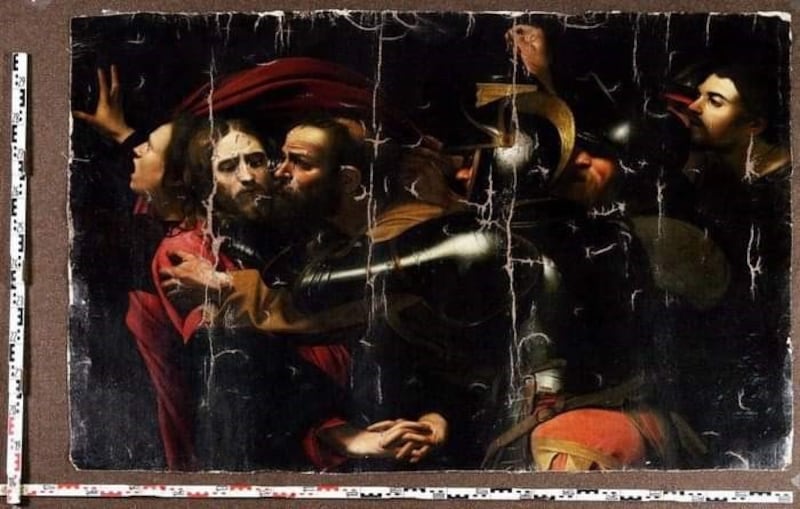
“There was no direct line to the painting,” says Formichev. “It was a circle of people who got us to the exact group that had stolen the painting; an interlocking web of criminal organisations – and not only criminals – also their sponsors in officialdom. I am in no doubt that this theft was carried out with a level of impunity on the part of the authorities. At that time, the mafia and the state were more or less the same thing.” The gang of thieves were “a young group, with no previous convictions. All we had on them is that they had stolen sports equipment from the Ukrainian Paralympic team. We did a psychological profile of them: they had families, kids and legal businesses – only one unit of their operations was art theft. They were talented: a classic mafia outfit with connections in law enforcement, and good at computer crime, which would have helped them get past the museum security systems.”
Formichev, his fellow agents and superiors in the police and ministry of justice spent “a lot of time creating my profile. I’d make it known that I could deal in pieces of art, but not directly. I’d carry paintings – mostly church stuff – in my bag. I pretended to be drunk at a party once, and left such a bag in the corner of a room. That’s how we finally found the group related to this case. [The mafioso] knew that they were looking for a buyer for the painting; I let it be known that I knew buyers for stolen art, and let them come to me. That was the mistake they made – they were trying to sell it, and through [the mafioso], they came to me. We spun a web, and they flew into it.” At one point, though, the mafia suspected Formichev of being exactly who he was, an undercover cop, “and they checked me out with some of their contacts in the police. Luckily, they either did not recognise me, or they did, but said nothing.”
Once contact was made, a number of “decoy” buyers were arranged, so that Formichev was not alone, to create a credible air of competition and “fog” – but in such a way that his supposed rivals would melt away. Formichev insisted to the gang “that negotiations could only begin when I assured my buyer it was an original Caravaggio, for which I needed to see it, and take samples to show my contact. I needed to see the painting physically. We had no idea whether it was in Ukraine or abroad, but they were speaking about international contacts, and we got a number in Germany to call. I rang it, and was told that the painting was in Berlin. Once they understood that no other buyers were involved, they asked me to come there and see it.”
[ Caravaggio: the heart of the storyOpens in new window ]
From then on, the investigation became an international one, with German colleagues “who were impressively precise, every dot and comma, as they are famous for”, and Italian experts who were “a bit more, er, ‘creative’, shall we say, like we Ukrainians”.
Four days before my third and final meeting with Formichev, Grain Power’s warehouses were hit by a Russian missile, during a summer barrage of the Danube ports, and disruption of crucial exports, mainly to Africa. “But we were loading the ships again 24 hours after the attack,” he says proudly.
Formichev’s description of the painting’s seizure is dramatic: “We had the whole area covered, around a metro station in Berlin. It wasn’t like it is now, with drones and stuff. I was led through a metro subway tunnel by one of the gang, and out to the street, which was empty. There, parked, was a truck. They opened the back of the vehicle, and shone a flashlight on to the damaged painting. There it was: the Caravaggio.” His feelings at that moment? “To be honest, I had the emotions of a cop, not an art historian. I thought: finally, it’s over. At last, I can take a vacation.”
However: “we had to make it look right, and the German police gave me a good beating they even kicked me in the head, and I spent a night in a German jail, with the thieves”.
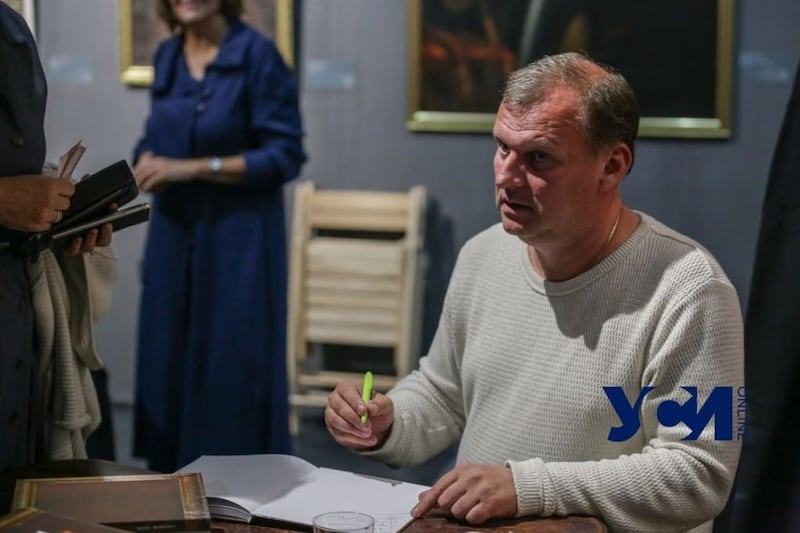
The painting was returned to Ukraine with fanfare: a joint press conference between then German chancellor Angela Merkel and Ukraine’s then pro-Russian president Viktor Yanukovych, later ousted by the Maidan “revolution of dignity” of a decade ago, which propelled Ukraine towards the war for freedom it fights today (Yanukovych fled to Russia). “We watched Merkel and Yanukovych on the news,” laughs Formichev, “and thought, ‘Oh God, now it’ll vanish again – he’ll take it to Russia’.”
He didn’t, but recovery was not the end of the picture’s tribulations. In a sorry state, it was handed over to the National Art Restoration Centre in Kyiv. There it was almost immediately confiscated by the courts as criminal evidence – either to find the culprits or cover up for them; because the picture languished in storage from 2010, while judicial proceedings – long outlasting Yanukovych’s ouster – went nowhere.
The then director of the Odesa museum, Vladymyr Ostrovskiy, protested that the painting was incorrectly stored, and suffering further damage. It needed stretching on a frame, he urged, to stop paint peeling from the folds, and this was not being done by the judicial authorities. For his pleas, Ostrovskiy was suddenly, and inexplicably, removed by the ministry of culture.
The legal documentation around the criminal case is labyrinthine. An examining judge, OO Pavelenko, is assigned, and five men are accused of the theft: Oleksiy Dymotrovych Balashov, Serhiy Viktorovicha Mole, Leri Levanovych Asatiani, Serhiy Viktorovicha Pidgorny and Tamazi Dursonovicha Chelidze (a Georgian citizen). But a hearing by the Podilsk District Court in Kyiv in 2013 was “eliminated” and the case sent for “a new trial in a different court”.
Nevertheless, another prosecutor was assigned by the same court in 2015, TV Sergeeva. A memo gives the case a number, 06-11735, and an indictment again accuses Balashov, Mole, Asatiani, Pidgorny and Chelidze (all with higher education degrees, it remarks) of “acting as part of an organised group” for the “theft of someone else’s property, namely the Odesa Museum of Western and Eastern Art”. A further indictment accuses all the above of “illegal movement [of the painting] across the customs border of Ukraine with concealment from customs control”.
There seems to be plenty for the indictments to go on: one undated memo says that recordings exist of Balashov planning the theft. The same document names Asatiani, and wonders “how the stolen property ended up in his possession” at a garage, the owner of which is sought by the authorities.
But the prosecutions appear to hold themselves up, then stall. None of the men have been convicted. A memo from one RI Rybchenko, representing the museum, notes “shortcomings in the pre-trial investigation” and makes reference to “the court’s self-removal from using all the measures provided by the criminal legal procedures of Ukraine”. A petition by Asatiani’s defence is upheld. An appeal is lodged by the museum “due to the one-sidedness and incompleteness of the judicial investigation”, but to no avail.
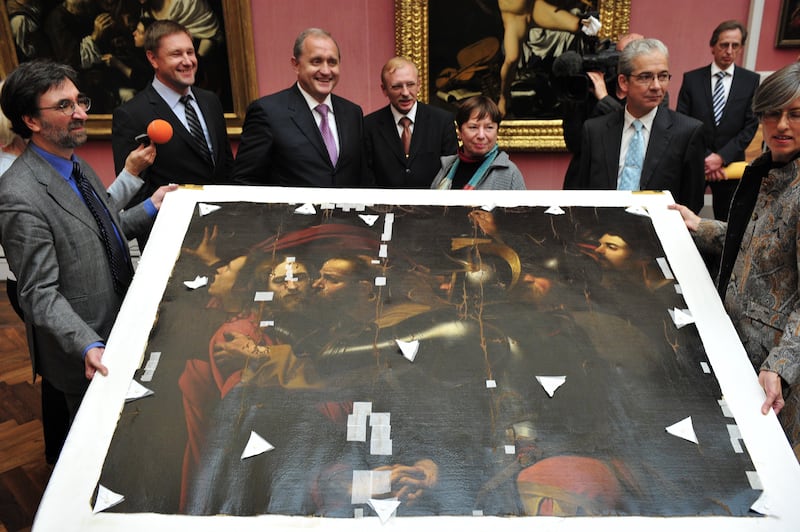
And still there is no sign of a trial, let alone a verdict. There have been no fresh hearings since 2016, none of the suspects are in custody and one has, reportedly, died since being indicted.
Meanwhile, concern deepened with regard to the painting’s condition. A memo of February 4th, 2016, cites a plea by the Odesa museum that “work on [the painting’s] restoration has not been carried out for more than five years. For a work of art more than four centuries old, in such a state, there can be irreversible consequences, and there is even a risk of losing this masterpiece.” Museum official Olga Kutsan protests that “further delay in carrying out restoration works is very dangerous”. Museum director Poronik urges in another petition to the court: “preservation of the artistic value and restoration of the painting The Arrest of Christ or The Kiss of Judas is not only the desire of the museum but the imperative duty of the state”.
In 2016, the museum appeals to a judge Otivenovsky that “today, this work of art of world importance is in the National Research and Restoration Center of Ukraine, but the necessary work on its restoration has not been carried out for six years . . . further delay in carrying our restoration may lead to irreversible damage”.
Finally, in March 2018, under pressure from the Italian embassy in Ukraine, the authorities granted permission for restoration to begin. Experts from the Palazzo Reale in Milano offered to help but were refused. In 2020, the Italian embassy again intervened, and international specialists were invited to join their Ukrainian colleagues to assist the restoration effort. Since which, access to it by specialists and diplomats from Italy has been eased by the election of President Volodymyr Zelenskiy, who has said he wants the painting to be returned to Odesa as soon as its safety can be vouchsafed. A request by me to see the painting earlier this year was refused by then minister of culture Oleksandr Tkachenko on the grounds that “all this is for another time”.
Formichev has collated his experiences into two books: one, Judas’ Kiss is a page-turning “thriller based on truth”, recounting the theft and recovery of the painting; the other is about “Caravaggio and corruption – endemic corruption, in this case, and more broadly”. (He talks about the arrest he made of a senior harbourmaster in Odesa who was working in cahoots with cocaine traffickers, and when apprehended “was in possession of $1.2 million in cash and a Colombian passport in the name of Jorge Fernández”.)
When asked whether he thought there was an element of official complicity in the theft, Formichev replies: “One hundred per cent, yes. This was a commissioned theft. But even to this day, I don’t know who commissioned it.” At all stages of the judicial inquiry into the stolen painting, he says, “I am convinced that politics and corruption played a part. Ministers have needed to say that previous administrations have to be blamed, investigations disappear into a black hole of procedure and time. There is no real effort to arrest and try the criminals, even though they are indicted. So many words in so many documents, and all for nothing. It’s fine for me to remember it all now, but at the time, it wasn’t fine at all – it was a serious and dangerous operation.”
He concludes: “It seems to be in Ukraine’s interest to close the case without convictions, and begin the debate as to whether it is a genuine Caravaggio or not. Thankfully, that discussion does not involve me – I’ve played my part.”
So: is this a Caravaggio, or a copy? If it is a copy, is it that of 1626 commissioned by the Mattei family from Giovanni di Attili, or by another, later artist unconnected to the original, like the painter of a further version of the scene in a private collection in Germany, and that which recently surfaced in Rome?
Throughout the legal papers, the painting is referred to as being – and presumed to be – by the hand of “Michelangelo Merisi da Caravaggio”, with no doubts cast. Edoardo Crisafulli, Italy’s learned and committed cultural attaché to Ukraine (recently transferred elsewhere) was and is a passionate advocate of his host country’s cause, and of getting the painting restored, attributed and back to Odesa when the military situation allows. He has urged the publication of Formichev’s books, and their translation into Italian, and says (over creditable pizza in Lviv): “Of course, I can make no expert judgment or take a position on attribution. But I hope it is original, for the sake of Odesa and Ukraine. It would be such a boost: to morale, and to potential tourism in the long run. I defer to the experts, and have faith in those who say it is genuine. I so hope they are right.”
The art historian to the fore in championing the authenticity of the Odesa Caravaggio, is Natalia Chechykova – with passion to match her expertise, and no wonder. Chechykova is a native of Odesa; she grew up with the painting as a schoolchild and then a teacher. She is currently working in Ferrara, northern Italy, and it is due to her research that the painting’s arrival in Russia from Paris came to light, likewise the vicissitudes of the painting’s journey through the 20th century.
Chechykova sets out her argument in an essay for a book called Caravaggio a Parigi – Caravaggio in Paris – published in June 2021. She follows the trail of the painting from Paris to Russia, Soviet re-attributions to Caravaggio during the 1930s, and praise for its “psychological depth”. Caravaggio was revered, she finds, as a “true revolutionary in his time”, painting “art close to reality, with his naturalism”. Chechykova then follows a rift between Soviet and western experts: she invokes Maliskaya in the Burlington Magazine of 1956, arguing that the Odesa painting is by Caravaggio’s own hand, while “western critics remained strongly sceptical of the attribution to Caravaggio”, writes Chechykova.
But it is radiographic work between 1951 and 1955 that preoccupies Chechykova most, done at Moscow’s Grabar Institute. These indicate, she posits, that the artist of the Odesa painting is not trying to reproduce a Caravaggio, but to paint the same scene with minor – important – differences. Among the reworking that Chechykova finds incompatible with a copy are the position of the hand of what is believed to be Caravaggio himself holding a lamp aloft; details to the face of the same supposed self-portrait, and a depiction of the visor clip of one of the soldier’s helmets – a floral design in the draft, and undecorated bolt in the finished work. All of which were different in this Odesa draft from what we know as the Dublin original. The expression on the face of Christ is also of a different mood, observes Chechykova.
“In this work,” writes Chechykova, ”Jesus does not seem to express the sense of helplessness in the face of what happens, as appears in the Dublin version. This inconsistency in terms of expressiveness seems not to agree with the hypothesis that the Ukrainian painting is a copy of the Merisi painting.”
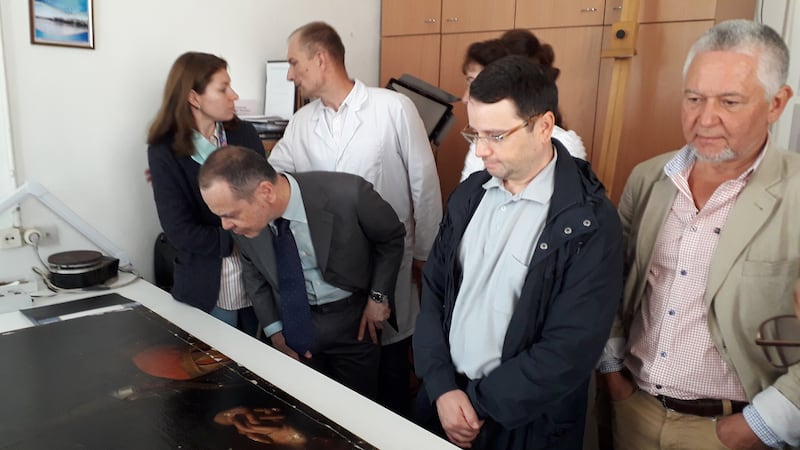
Chechykova argues that “analysis of the X-rays clearly shows that changes and second thoughts emerge from the first draft to the final definition of the composition. A series of anomalies that should have made art historians reflect.” She adds: “If we want to admit that the canvas is a copy made by a painter who had been commissioned to make a faithful replica of Caravaggio’s work, the modifications and corrections present should be read as truly serious errors . . . given the precision and excellent pictorial technique.”
Chechykova concludes by urging “a more attentive reconsideration of [the Odesa painting’s quality, and its possible autograph by Caravaggio”.
Hers is an academic paper, but there is palpable emotion between the lines, which erupt in conversation. “I love this painting,” she says, and uses the word many times, with committed enthusiasm. “This Caravaggio has been the backdrop to my life. My mother, a civil engineer, took me to see it when I was a little girl, as part of my education in Italian art, in which she was learned. I went to stare at it as an older child, then as a student writing a thesis about Italy and Odesa, then as a teacher of history and Italian. I must have taken hundreds of people to look at this masterpiece.”
To demonstrate that the painting is by Caravaggio “is my life’s calling and my dream”, she says. “The whole history of the work is a drama, a romance – surviving through wars, robbery, debate over who painted it.” The painting was “considered to be by Caravaggio, according to Soviet scholarship, but the attribution fell apart along with the USSR. As the Soviet Union collapsed in the 1990s, and the painting came west, so the attribution to Caravaggio fell apart with it.” Chechykova began serious work on re-asserting its originality when accepted at the University of Ferrara in 2015. “Thanks to Dottoressa Cappelletti, I was able for the first time to go to the sources, the documentation and the supporting materials.”
On the radiography, she says: “The first draft beneath what we see is too different. It is another painting beneath the so-called ‘copy’ – not a copy at all. Most of all, it is another Christ, a human being in a different mood to that of the Dublin painting who is being apprehended.” Her insistence “takes nothing from the Irish picture”, she says, “I think the strongest possibility is that they are both by Caravaggio. My fantasy is to see them both exhibited side by side at the Borghese in Rome.”
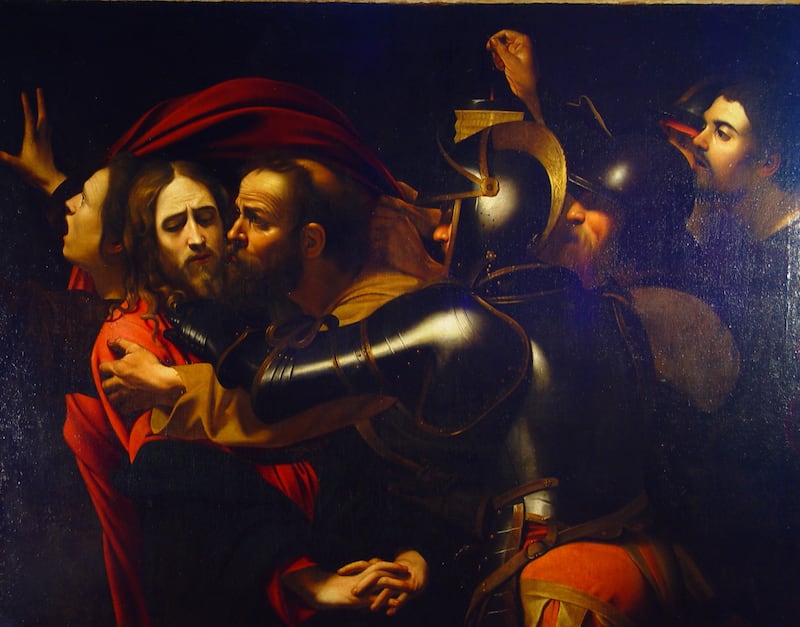
Among the legal papers, a memo of 2016 argues that “in order to investigate the authorship of the picture, consultations will be held with the National Gallery of Ireland and Hermitage in St Petersburg”. The latter is now unlikely, but we can stand by for the approach to Ireland.
Benedetti, who died in 2018, believed that “the large number of copies found to date should therefore not mislead us. Examination of these, even if based largely on photographs, leads one to surmise that the Odesa painting may have been one of the few to have been copied directly from the original.” But “the case of the Dublin picture is, as we have seen, quite different. It is obviously superior in quality to the Odesa version, which although faithful to Caravaggio’s in design, reveals its status as a copy by the evident weaknesses of its execution.” (Chechykova retorts: “He said it was not by Caravaggio. A dry deduction. I demonstrate that it is.”)
Reassured by unanimity over its own Caravaggio, the National Gallery of Ireland is now less dogmatic than Benedetti about the Odesa picture, and open to whatever scholarship ensues. Aoife Brady, curator of Italian and Spanish art (recent curator of a revelatory exhibition of work by Lavinia Fontana), ponders the latest reports from Odesa over coffee at the gallery’s cafeteria; a long way from missiles pounding Odesa, but connected by this adventure.
“I’ve not seen the painting,” she says, “so cannot make any judgment on whether it is a Caravaggio or not. But” – and here she makes an intriguing, more general point – “I do think that we are obsessed with singularity in the 21st century in a way that was not so in the 17th. Our concept of originality is somewhat anachronistic: this idea that ‘we have the only and true masterpiece’. What people wanted back then was something of status, but many collectors or buyers would have been happy with an ‘autograph copy’, that is to say, a duplicate by the original master, or a copy from within the workshop. We know that Caravaggio did not have much of a workshop, so there would have been a very limited supply of ‘autograph copies’, if indeed they were produced. But for there to be more than one painting by Caravaggio of the same subject is perfectly possible.”
Dr Brady addresses so-called “pentimenti” beneath the surface of the Odesa picture – the traces of the artist’s earlier ideas behind the finished composition, as discussed by Chechykova. “The presence of pentimenti”, she says, “does not necessarily imply originality – even copyists changed their minds, corrected mistakes, or adapted ideas when creating reproductions. Copying was conventional practice, even for successful and established artists. Copyists often deliberately introduced variations to the compositions they were duplicating, since creativity and copying were closely linked – an alien notion to us today, but well understood in the early modern period. Sometimes patrons requested that artists introduce variations to copies that they were commissioning. They valued the artist’s creativity: copying was not necessarily viewed as a slavish mechanical process.
“The specific nature of pentimenti is more important to questions of originality or attribution” continues Brady. “Certain kinds of pentimenti can be associated with specific artists, and their working methods. We can associate certain quirks with Caravaggio’s technique, for example: he often positioned his figures on the canvas by first painting their ear, using this as an anchor around which to work. In our painting, a pentimento has been identified that relates to the repositioning of Judas’ ear. This speaks to Caravaggio’s initial laying out of the composition. The Odesa painting also has pentimenti, but does not appear to be of the same character.”
Brady concludes, on Benedetti’s discovery: “It’s fair to say that what we have here in Dublin is the prime painting in a series, if there is a series. The documentary evidence is convincing, and almost all scholars are in agreement. But that doesn’t dismiss the possibility of others.” And yet: “even if this is not another Caravaggio, it doesn’t necessarily matter, or at least it doesn’t negate the painting. Let’s see what the experts say – but whatever they conclude, it doesn’t take away from what they have there in Odesa.”
“It matters,” Odesa museum director Poronik begs, respectfully, to differ. “It matters that this painting is returned to us by the government, in the best condition we can hope for. Its journey has been too long, its adventures too arduous. And it matters that the painting be seen by the world: Ukraine’s Caravaggio.”
Ed Vulliamy is a war reporter and former Guardian and Observer writer




















